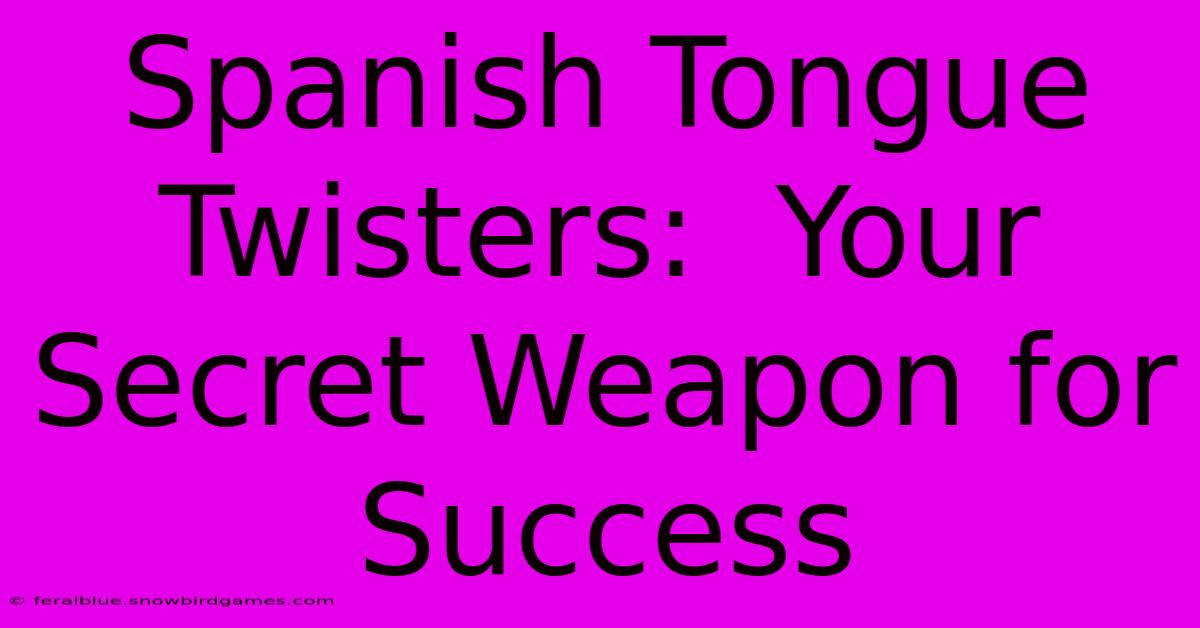Spanish Tongue Twisters: Your Secret Weapon For Success

Table of Contents
Spanish Tongue Twisters: Your Secret Weapon for Success
Learning a new language can be challenging, but mastering pronunciation is key to fluency. And what better way to conquer tricky sounds and improve your overall speaking skills than with tongue twisters? Spanish, with its vibrant sounds and unique phonetic rules, offers a treasure trove of these playful challenges. This article will explore the benefits of using Spanish tongue twisters and provide you with some fantastic examples to practice.
Why Use Spanish Tongue Twisters?
Tongue twisters aren't just a fun way to pass the time; they're a powerful tool for language learners. Here's why incorporating them into your Spanish learning journey is a smart move:
-
Improved Pronunciation: The repetitive nature of tongue twisters helps you practice specific sounds and sound combinations, improving your accuracy and clarity. This is especially helpful for mastering tricky sounds like the rolled "r" or the subtle differences between similar vowels.
-
Enhanced Fluency: By repeatedly practicing these phrases, you'll build muscle memory in your mouth and tongue, leading to smoother and more natural speech. This translates to increased confidence and fluency when speaking Spanish.
-
Increased Vocabulary: Many tongue twisters use common words and phrases, subtly expanding your vocabulary in a fun and engaging way. You'll absorb new words organically without feeling like you're memorizing a vocabulary list.
-
Boosted Confidence: Mastering a difficult tongue twister can be incredibly satisfying. This sense of accomplishment boosts your confidence and motivates you to continue learning. It proves you're making progress!
-
Fun and Engaging Learning: Let's be honest – learning can sometimes feel tedious. Tongue twisters inject fun and playfulness into the learning process, making it more enjoyable and less daunting.
Top Spanish Tongue Twisters to Try
Here are some excellent Spanish tongue twisters, ranging in difficulty, to challenge and improve your skills:
Beginner Level:
-
"Pablito clavó un clavito, ¿Qué clavito clavó Pablito?" (Pablito hammered a little nail, what little nail did Pablito hammer?) – This focuses on the "cl" sound.
-
"Tres tristes tigres, tragaban trigo en un trigal." (Three sad tigers were eating wheat in a wheat field.) – This practices the "tr" sound and the repetition of "tri."
-
"El perro de San Roque no tiene rabo, porque Ramón Ramírez se lo robó." (San Roque's dog doesn't have a tail because Ramón Ramírez stole it.) – This twister works on several sounds and is a classic!
Intermediate Level:
-
"Si quieres comprar paraguas, compra paraguas, pero no compres paraguas, compra paragüas." (If you want to buy umbrellas, buy umbrellas, but don't buy umbrellas, buy umbrellas.) – Pay attention to the subtle difference in pronunciation between "paraguas" (umbrellas) and "paraguas" (paraguas). This highlights stress and intonation.
-
"Erre con erre, guitarra; erre con erre, barril; rápido corren los carros del ferrocarril." (R with r, guitar; r with r, barrel; the railway cars run fast.) – A great one for mastering the rolled "r."
Advanced Level:
-
"Para que Paco pique papas, necesita un pico y una pala." (For Paco to chop potatoes, he needs a pickaxe and a shovel.) – This tests your ability to handle rapid sounds and maintain clarity.
-
"Me encontré a un perro en el parque, pero el perro no me encontraba a mí." (I found a dog in the park, but the dog did not find me.) This focuses on precise pronunciation and subtle differences between sounds.
Pro-Tip: Record yourself saying the tongue twisters. Listening back helps identify areas needing improvement and track your progress.
Incorporating Tongue Twisters into Your Routine
The best way to benefit from tongue twisters is to make them a regular part of your Spanish learning routine. Try the following:
-
Daily Practice: Dedicate a few minutes each day to practicing one or two twisters.
-
Start Slow: Don't rush. Focus on accuracy over speed at first. Gradually increase your speed as you become more comfortable.
-
Break It Down: If a twister is particularly challenging, break it down into smaller chunks. Practice each chunk individually before putting it all together.
-
Have Fun!: Remember that the goal is to improve your Spanish, but it's also to have fun! Don't get discouraged if you stumble – keep practicing, and you'll see improvements over time.
By embracing the challenge of these playful phrases, you'll unlock a significant boost in your Spanish pronunciation and fluency. So, grab a twister, and get ready to speak Spanish with confidence and flair!

Thank you for visiting our website wich cover about Spanish Tongue Twisters: Your Secret Weapon For Success. We hope the information provided has been useful to you. Feel free to contact us if you have any questions or need further assistance. See you next time and dont miss to bookmark.
Featured Posts
-
Meghan Markles Age A Look Back A Look Ahead
Apr 05, 2025
-
The Mysterious Villa Daughter In Law Manga
Apr 05, 2025
-
Faysal Qureshi S Son The Unexpected Truth
Apr 05, 2025
-
Michael Polansky Age A Fascinating Look At His Life
Apr 05, 2025
-
Lily Rose Depp Beyond The Celebrity Bubble
Apr 05, 2025
